The PixelPlane Editor: Difference between revisions
No edit summary |
No edit summary |
||
| Line 20: | Line 20: | ||
---- | ---- | ||
[[File:HLS_PixelPlaneEditor_MegaTree_Layout.png| | [[File:HLS_PixelPlaneEditor_MegaTree_Layout.png|350px|Figure 6-9]] | ||
Figure 6-9 is the layout of the PixelPlane Editor when editing a MegaTree pixel object. Description of the highlighted areas and what they mean follows. These will each be explained in detail further in this document. | Figure 6-9 is the layout of the PixelPlane Editor when editing a MegaTree pixel object. Description of the highlighted areas and what they mean follows. These will each be explained in detail further in this document. | ||
Latest revision as of 06:57, 24 March 2013
Current as of Version 12Z.
Introduction to the PixelPlane Editor
The PixelPlane Editor was introduced in Version 12A of HLS. This Editor allows the user to apply a variety of complex and customizable effects to an entire pre-defined PixelPlane object. This document will cover how to use the PixelPlane Editor and apply effects in a sequence. There are sub-pages to address how to apply effects to various PixelPlane objects. First, you must create the PixelPlane before adding these effects.
Activating the PixelPlane Editor
To activate the PixelPlane Editor, you must Right-Click in the grid cell of the PixelPlane you are editing.
- Tip: You don't have to have the exact grid cell you want to start the effect in, but you probably want to be around the right area. You can adjust the starting cell and the length of the effect later.
- When you right-click, select Add HLS Custom PixelPlane Effect from the menu that opens.
- This will open the PixelPlane Editor.
Window Layout and Explanations
Figure 6-9 is the layout of the PixelPlane Editor when editing a MegaTree pixel object. Description of the highlighted areas and what they mean follows. These will each be explained in detail further in this document.
- Assigned Effects: The areas at the top highlighted in Purple show the PixelPlane effects that have been created for the PixelPlane. The current effect being added or modified appears green. Any other PixelPlane effects will appear in blue while in PixelPlane Editor.
- Animation window: The large, black area highlighted in blue is the animation window where the effect you are working on will appear. This will give you a good idea as to what your effect will look like live. Toggle the Animate the Effect checkbox to turn this on and off.
- Effect Category: The pull-down selection menu highlighted in blue (and that reads "Spiral") is where you select from the categories of effects that HLS has built-in for MegaTrees.
- Frame Count shows the frames that the sequencer will generate for your effect.
- Assign Channels to Pixels: Use this to tell HLS how your pixels are arranged on your MegaTree.
- Single Step: Step through the effect one frame at a time.
- Reset: Reset the animation/effect back to frame 1.
- Select Beat Track: Assign a beat track to be used with other beat track features of the editor.
- Enable Beat Track: Check this to turn on the beat track features.
- Effect Customization: The section highlighted in Yellow is used to customize the selected MegaTree effect. Each type of effect has it's own customization options, which will change based on which effect is chosen.
- Color Selection: The area highlighted in Red is used to select the colors used with the effect. A few or several colors can be used.
- Select Existing Effect to Use: This button is to open an effect that you have previously created in the editor.
- Random Color: Use random colors with the effect.
- Text: The area highlighted in Orange controls text generation.
- Beat Track: Lock Rotation and Flash Pixels at Beat Track are used to tie the effect into the previously assigned beat track.
- Create/Replace Effect: Pressing this button will create the effect. If you have not entered a new name, your previously named effect will be overwritten.
- Name of this Effect: The name associated with the effect.
Using Colors with Effects
Color for effects can be one of two types:
- Solid colors
- Color Shifts from one color to another along the color wheel.
- These two types can be used
The Solid Colors are the six blocks of colors along the top row. These can be changed by left-clicking a color. A Color Picker window will open allowing you the ability to change the color. When the radio button next to these colors is selected, you will be using that solid color.
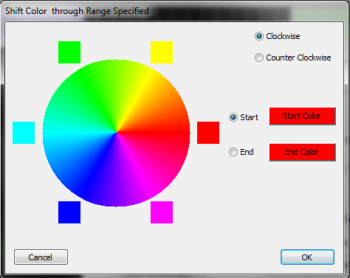
The Color Shift colors are the sets of color blocks along the second and last rows. These can be changed by left-clicking the first color block. A color wheel will open (See Figure 6-11). Choose the starting color and the ending color by selecting one of the squares along the wheel. In the effect, this will cause a "color shift" from the start color to the end color, all along the color wheel. You can even choose the same start and end color to shift the entire spectrum of color. Select clockwise or counter-clockwise to set the direction to move along the color wheel.
The checkbox at the bottom of each column tell HLS whether you want that color active. You can have a total of six active colors or color shifts.
The Color Shift slider tells HLS whether you want the color shift to slide through the PixelPlane object. If this is set at 0, the colors will remain stationary. If you move it up, the colors will begin sliding through the object.
The Random Color checkbox will apply the effect with random color assignment.
Using a Beat Track with a PixelPlane
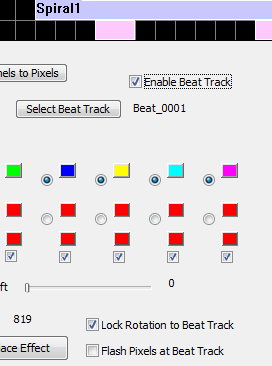
The power of the built-in HLS PixelPlane Editor is truly revealed when syncing the generated effects with the sequence music. There are two types of synchronization:
- Syncing a rotation with a beat track or pre-determined mark.
- Syncing a flashing effect with a beat track or pre-determined mark.
Syncing Rotation or Flash:
- Click the Select Beat Track button and choose a beat track or other reference track.
- Click Enable Beat Track to display the beat track along with your PixelPlane effect.
- At this point, you can adjust the start and end points of your effect to fit alongside beats if you desire.
- Select Lock Rotation to Beat Track or Flash Pixels at Beat Track to sync up effect with track.
- Click Create/Replace Effect to generate the sequence data.
- Click Done to exit the editor.
Assigning Channels to Pixels
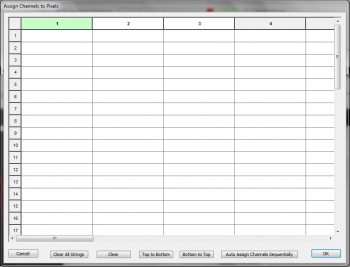
- HLS needs to understand how your pixels are arranged on your PixelPlane object to be able to correctly assign pixels to positions. To do this, HLS has an Assign Channels to Pixels button in the PixelPlane Editor.
- Click the Assign Channels to Pixels button from the PixelPlane Editor.
- Figure 6-13 will appear.
- This grid contains the layout of your PixelPlane object. The Columns represent the strands of pixels, and the rows represent the pixels in each strand. This is defined when you setup your PixelPlane object.
- Note: Notice that the first column is green. Left-click on the first column header to select it. You must do this before any channel assignment can take place.
- The buttons at the bottom serve specific purposes:
- Cancel: Cancels the Pixel Assignment window.
- Clear All Strings: Clears any previously set strand assignment.
- Clear: Clears a specific string.
- Top to Bottom: Means your strings are arranged with the first pixel at top and last pixel at bottom.
- Bottom to Top: Means your strings are arranged with the first pixel at bottom and last pixel at top.
- Auto Assign Channels Sequentially: Once the first string is assigned, this will complete the rest of the string assignment.
- OK: Save changes and close.
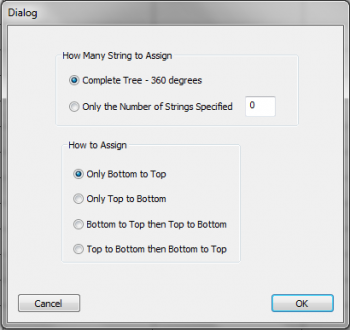
Auto Assign Channels Sequentially:
- To Auto Assign Channels, first, make sure the header for string 1 is selected (it will be green).
- Click Auto Assign Channels Sequentially.
- Figure 6-14 will appear.
- Choose whether to complete the whole tree, or, if using less than a full tree, fill in the number of strings you will be using.
- Choose how your pixels will be physically arranged on the object.
- Click OK.
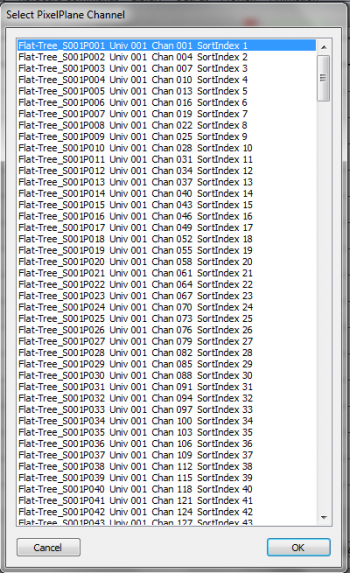
- Figure 6-15 will appear. Select the First String, First Pixel.
- Click OK.
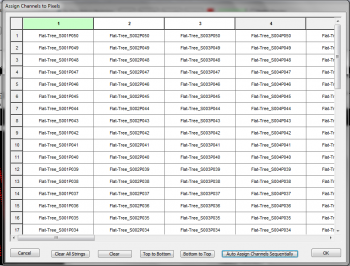
- The Channel Assignment grid will once again appear (See Figure 6-16).
- Channels will now be auto-assigned based on your settings.
- Click OK to complete assignment.
- Tip: HLS will remember this assignment for any additional PixelPlane effects that you generate in the sequence.
Naming the PixelPlane Effect
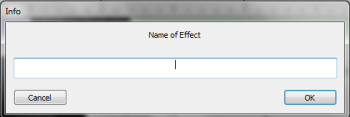
- PixelPlane effects must be named before they can be generated into a sequence.
- To name your PixelPlane effect, click the Name of This Effect button.
- Figure 6-17 will appear.
- Type in the name of your effect and hit OK. The assigned name will update to the new name.
- Note: When you add an additional effect, it will automatically be set for the last assigned name. You must change the assigned name if you do not want your saved effect being overwritten in the editor.
Generating the PixelPlane Effect
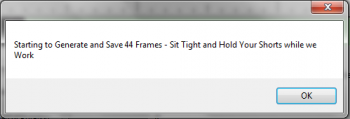
- An effect will not be created until you click the Create/Replace Effect button.
- When you click that button, HLS will begin to generate the frames needed to place the effect into the sequence.
- Figure 6-18 will appear. Depending on the number of frames to generate (see the frame count for your effect), this may take time to complete.
- As the frames are generated, the animation window should update.
- When complete, press DONE to exit the PixelPlane Editor.
Modifying PixelPlane Effects
Modifying Effect Content:
- To modify an existing PixelPlane effect, right-click on the effect and chose, Modify This Effect.
- This will open the PixelPlane Editor.
- From the editor, you can change any of the effect settings that were previously created.
- When complete, click the Create/Replace Effect button to re-generate the edited effect.
- Click Done and OK to close the editor window.
Moving/Resizing PixelPlane Effects:
- Unlike regular channel effects, you can only move or resize PixelPlane effects created with the editor while the editor is open for that effect.
- To move or resize the effect, right-click on the effect and chose, Modify This Effect.
- From the editor, you can click on the first cell and drag to move the start point.
- You can click on the last cell to shrink or expand the pixel effect.
- When complete, click the Create/Replace Effect button to generate the needed frames for the new length of the effect.
- Click Done and OK to close the editor window.
Re-Using a PixelPlane Effect
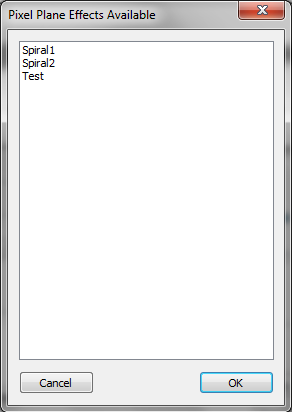
- To re-use a previously created PixelPlane effect, Right-Click in the sequencer window on the PixelPlane channel and choose Add HLS Custom PixelPlane Effect.
- Figure 6-19 will appear with a list of all previously saved PixelPlane effects.
- Select the effect you want and click OK.
- Make any needed adjustments, then click Create/Replace Effect to generate the frames into the sequence.
PixelPlane Objects with Predefined Effects
HLS has a set of predefined effects for some PixelPlane objects:
| HLS User Manual and Reference Guide | ||
|---|---|---|
| Previous Page | Current Chapter | Next Page |
| Creating a PixelPlane | Chapter 6: Creating and Using PixelPlanes | The PixelPlane Editor: Creating Effects |